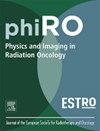新的直肠剂量面测绘方法确定与前列腺癌放疗后毒性相关的直肠亚区
IF 3.4
Q2 ONCOLOGY
引用次数: 0
摘要
背景和目的越来越多的证据表明,直肠表面的空间剂量变化影响放射治疗后的毒性风险。现有的方法采用固定的、任意的物理范围进行直肠剂量测绘,限制了它们的分析。我们开发了一种标准化直肠轮廓的方法,将其展开成二维圆柱形表面图,并确定高剂量增加直肠毒性的亚区域。材料和方法采用来自REQUITE研究的1048例前列腺癌患者的数据。生成基于深度学习的自动分割以确保一致性。直肠长度采用前列腺上下线性变换进行标准化。通过圆柱映射的轮廓变化评估,验证了自动轮廓与人工轮廓的对比。使用学生t置换检验和Cox比例风险模型(CPHM)对针对个体直肠毒性的手动和自动等高线的剂量面图进行基于体素的分析。通过排列检验确定显著性。结果采用自动分割方法对1048例患者进行了分析。学生t检验显示显著性(p <;0.05)在临床报告的直肠炎和患者报告的肠急症中出现下后侧。单变量CPHM发现,临床报告的直肠炎风险每Gy增加3%,患者报告的后下肠急症风险每Gy增加2%。其他终点无显著性差异。结论:我们开发了一种将直肠展开成二维表面图的方法。对于临床报告的直肠炎和患者报告的肠急症,下后侧具有重要意义,表明减少该区域的剂量可以降低毒性风险。本文章由计算机程序翻译,如有差异,请以英文原文为准。
New rectum dose surface mapping methodology to identify rectal subregions associated with toxicities following prostate cancer radiotherapy
Background and purpose
Growing evidence suggests that spatial dose variations across the rectal surface influence toxicity risk after radiotherapy. Existing methodologies employ a fixed, arbitrary physical extent for rectal dose mapping, limiting their analysis. We developed a method to standardise rectum contours, unfold them into 2D cylindrical surface maps, and identify subregions where higher doses increase rectal toxicities.
Materials and methods
Data of 1,048 patients with prostate cancer from the REQUITE study were used. Deep learning based automatic segmentations were generated to ensure consistency. Rectum length was standardised using linear transformations superior and inferior to the prostate. The automatic contours were validated against the manual contours through contour variation assessment with cylindrical mapping. Voxel-based analysis of the dose surface maps for the manual and automatic contours against individual rectal toxicities was performed using Student’s t permutation test and Cox Proportional Hazards Model (CPHM). Significance was defined by permutation testing.
Results
Our method enabled the analysis of 1,048 patients using automatic segmentation. Student’s t-test showed significance (p < 0.05) in the lower posterior for clinical-reported proctitis and patient-reported bowel urgency. Univariable CPHM identified a 3 % increased risk per Gy for clinician-reported proctitis and a 2 % increased risk per Gy for patient-reported bowel urgency in the lower posterior. No other endpoints were significant.
Conclusion
We developed a methodology that unfolds the rectum to a 2D surface map. The lower posterior was significant for clinician-reported proctitis and patient-reported bowel urgency, suggesting that reducing the dose in the region could decrease toxicity risk.
求助全文
通过发布文献求助,成功后即可免费获取论文全文。
去求助
来源期刊

Physics and Imaging in Radiation Oncology
Physics and Astronomy-Radiation
CiteScore
5.30
自引率
18.90%
发文量
93
审稿时长
6 weeks
 求助内容:
求助内容: 应助结果提醒方式:
应助结果提醒方式:


